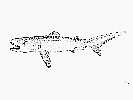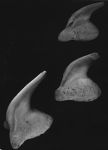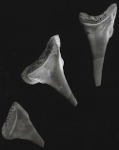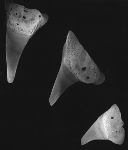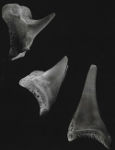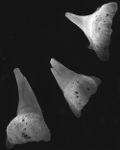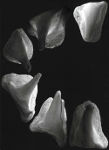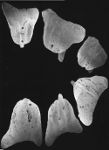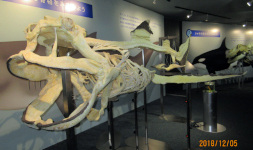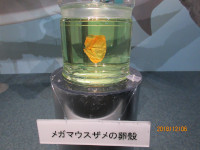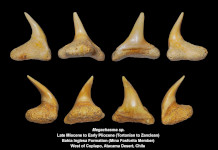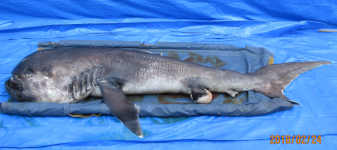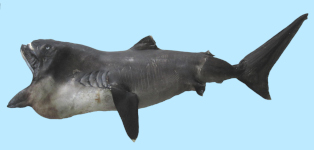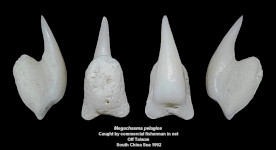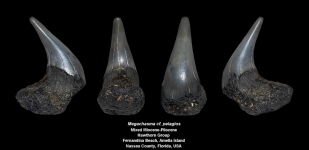Megachasma pelagios
Taylor, Compagno & Struhsaker, 1983
Megamouth shark
Classification: Elasmobranchii Lamniformes Megachasmidae
Reference of the original description
Megamouth a new species, genus and family of lamnoid sharks, Megachasma pelagios (Family Megachasmidae), from the Hawaiian Islands. Proceedings of the California Academy of Sciences, (Series 4), 43(8), 87–110
Megamouth a new species, genus and family of lamnoid sharks, Megachasma pelagios (Family Megachasmidae), from the Hawaiian Islands. Proceedings of the California Academy of Sciences, (Series 4), 43(8), 87–110
Image of the original description
Image in copyright.
Image in copyright.
Synonyms / new combinations and misspellings
Megachasma aff. pelagios, Megachasma cf. pelagios
Megachasma aff. pelagios, Megachasma cf. pelagios
Description :
Citation: Megachasma pelagios Taylor, Compagno & Struhsaker, 1983: In: Database of modern sharks, rays and chimaeras, www.shark-references.com, World Wide Web electronic publication, Version 05/2025
Please send your images of "Megachasma pelagios" to info@shark-references.com
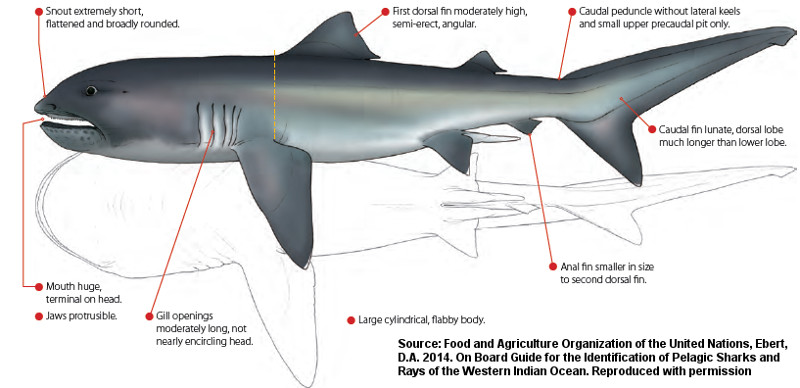
Megachasma pelagios Taylor, Compagno & Struhsaker, 1983, © FAO, Food and Agriculture Organization of the United Nations, Ebert, D.A. 2014. On Board Guide for the Identification of Pelagic Sharks and Rays of the Western Indian Ocean. Reproduced with permission, illustration by Marc Dando , Wildlife Illustrator

Megachasma pelagios Taylor, Compagno & Struhsaker, 1983, © FAO, Food and Agriculture Organization of the United Nations, Ebert, D.A. 2014. On Board Guide for the Identification of Pelagic Sharks and Rays of the Western Indian Ocean. Reproduced with permission, illustration by Marc Dando , Wildlife Illustrator
Common names
 Tiburón bocudo,
Tiburón bocudo,  Tiburón bocón,
Tiburón bocón,  Requin grande guele,
Requin grande guele,  Requin grande gueule,
Requin grande gueule,  Megamouth shark
Megamouth shark
 Tiburón bocudo,
Tiburón bocudo,  Tiburón bocón,
Tiburón bocón,  Requin grande guele,
Requin grande guele,  Requin grande gueule,
Requin grande gueule,  Megamouth shark
Megamouth shark
Short Description
Body stout, tapering posteriorly [1388], tadpole-like with larger head and tapering trunk and tail (Ref. 47786). Snout extremely short but broadly rounded [531] (Ref. 47786). Head huge, blubbery [1388]. Mouth very broad and terminal on head, with corner extending behind the eyes [1388] [531]. Jaws huge, protrusible anteriorly but not greatly distensible laterally [531] (Ref. 47786), lower jaw extending to snout tip [1388]. Teeth very small, numerous, hooked [1388] [531] (Ref. 47787). Gill slits moderately long, not reaching dorsal surface of head [1388] [531], internal gill slits lined with dense rows of papillose gill rakers [531]. Eyes semicircular (Ref. 47786), with no nictitating membrane [1388] [531](Ref. 47786). Two dorsal fins, relatively low and angular; small anal fin; long, narrow pectoral fins; moderate-sized pelvic fin; caudal fin asymmetrical, non-lunate, with a short and strong ventral lobe; upper pre-caudal pit only; caudal peduncle without keels or ridges [1388] [531].
Body stout, tapering posteriorly [1388], tadpole-like with larger head and tapering trunk and tail (Ref. 47786). Snout extremely short but broadly rounded [531] (Ref. 47786). Head huge, blubbery [1388]. Mouth very broad and terminal on head, with corner extending behind the eyes [1388] [531]. Jaws huge, protrusible anteriorly but not greatly distensible laterally [531] (Ref. 47786), lower jaw extending to snout tip [1388]. Teeth very small, numerous, hooked [1388] [531] (Ref. 47787). Gill slits moderately long, not reaching dorsal surface of head [1388] [531], internal gill slits lined with dense rows of papillose gill rakers [531]. Eyes semicircular (Ref. 47786), with no nictitating membrane [1388] [531](Ref. 47786). Two dorsal fins, relatively low and angular; small anal fin; long, narrow pectoral fins; moderate-sized pelvic fin; caudal fin asymmetrical, non-lunate, with a short and strong ventral lobe; upper pre-caudal pit only; caudal peduncle without keels or ridges [1388] [531].
Distribution
Pacific Ocean: Japan, Indonesia, Philippines, Hawaii and California, USA. Atlantic Ocean: Brazil and Senegal. Source: www.gbif.org
Pacific Ocean: Japan, Indonesia, Philippines, Hawaii and California, USA. Atlantic Ocean: Brazil and Senegal. Source: www.gbif.org
Human uses
fisheries: of no interest
fisheries: of no interest
Biology
Exhibit ovoviparity (aplacental viviparity), with embryos feeding on other ova produced by the mother (oophagy) after the yolk sac is absorbed [733]. Distinct pairing with embrace [17086]. Oceanic, possibly occurring in depths between 150 and 1,000 m [1388]. Feeds on planktivorous prey such as euphausiid shrimps, copepods and jellyfish [1388]. May also eat small midwater fishes. Possibly less active than the basking and whale sharks [1388]. Its feeding habits and habitat suggest that it may be a rare catch in the future.
Exhibit ovoviparity (aplacental viviparity), with embryos feeding on other ova produced by the mother (oophagy) after the yolk sac is absorbed [733]. Distinct pairing with embrace [17086]. Oceanic, possibly occurring in depths between 150 and 1,000 m [1388]. Feeds on planktivorous prey such as euphausiid shrimps, copepods and jellyfish [1388]. May also eat small midwater fishes. Possibly less active than the basking and whale sharks [1388]. Its feeding habits and habitat suggest that it may be a rare catch in the future.
Habitat
pelagic-oceanic; oceanodromous [17660]; marine; depth range 5 - 600 m [17640], usually 120 - 166 m (Ref. 48844)
pelagic-oceanic; oceanodromous [17660]; marine; depth range 5 - 600 m [17640], usually 120 - 166 m (Ref. 48844)
Remarks
shark-references Species-ID=3605;
shark-references Species-ID=3605;
Parasites (arranged by Jürgen Pollerspöck)
Cestoda
Copepoda
Cestoda
- Corrugatocephalum ouei Caira, Jensen & Yamane, 1997 [16274] [16338]
- Mixodigma leptaleum Dailey & Vogelbein, 1982 [17846] [16274] [16112]
Copepoda








